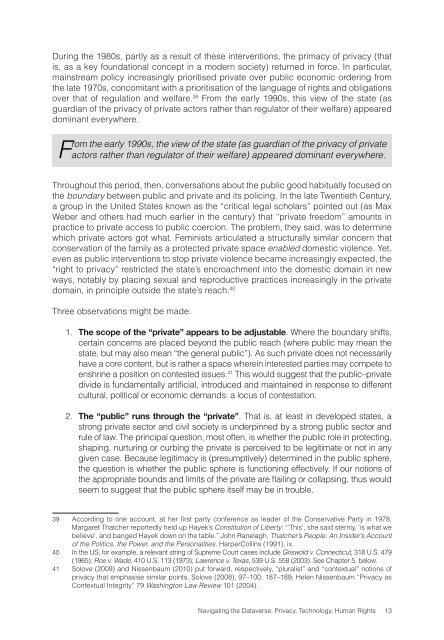Navigating the Dataverse: Privacy, Technology ... - The ICHRP
Navigating the Dataverse: Privacy, Technology ... - The ICHRP
Navigating the Dataverse: Privacy, Technology ... - The ICHRP
Create successful ePaper yourself
Turn your PDF publications into a flip-book with our unique Google optimized e-Paper software.
During <strong>the</strong> 1980s, partly as a result of <strong>the</strong>se interventions, <strong>the</strong> primacy of privacy (that<br />
is, as a key foundational concept in a modern society) returned in force. In particular,<br />
mainstream policy increasingly prioritised private over public economic ordering from<br />
<strong>the</strong> late 1970s, concomitant with a prioritisation of <strong>the</strong> language of rights and obligations<br />
over that of regulation and welfare. 39 From <strong>the</strong> early 1990s, this view of <strong>the</strong> state (as<br />
guardian of <strong>the</strong> privacy of private actors ra<strong>the</strong>r than regulator of <strong>the</strong>ir welfare) appeared<br />
dominant everywhere.<br />
From <strong>the</strong> early 1990s, <strong>the</strong> view of <strong>the</strong> state (as guardian of <strong>the</strong> privacy of private<br />
actors ra<strong>the</strong>r than regulator of <strong>the</strong>ir welfare) appeared dominant everywhere.<br />
Throughout this period, <strong>the</strong>n, conversations about <strong>the</strong> public good habitually focused on<br />
<strong>the</strong> boundary between public and private and its policing. In <strong>the</strong> late Twentieth Century,<br />
a group in <strong>the</strong> United States known as <strong>the</strong> “critical legal scholars” pointed out (as Max<br />
Weber and o<strong>the</strong>rs had much earlier in <strong>the</strong> century) that “private freedom” amounts in<br />
practice to private access to public coercion. <strong>The</strong> problem, <strong>the</strong>y said, was to determine<br />
which private actors got what. Feminists articulated a structurally similar concern that<br />
conservation of <strong>the</strong> family as a protected private space enabled domestic violence. Yet,<br />
even as public interventions to stop private violence became increasingly expected, <strong>the</strong><br />
“right to privacy” restricted <strong>the</strong> state’s encroachment into <strong>the</strong> domestic domain in new<br />
ways, notably by placing sexual and reproductive practices increasingly in <strong>the</strong> private<br />
domain, in principle outside <strong>the</strong> state’s reach. 40<br />
Three observations might be made:<br />
1. <strong>The</strong> scope of <strong>the</strong> “private” appears to be adjustable. Where <strong>the</strong> boundary shifts,<br />
certain concerns are placed beyond <strong>the</strong> public reach (where public may mean <strong>the</strong><br />
state, but may also mean “<strong>the</strong> general public”). As such private does not necessarily<br />
have a core content, but is ra<strong>the</strong>r a space wherein interested parties may compete to<br />
enshrine a position on contested issues. 41 This would suggest that <strong>the</strong> public–private<br />
divide is fundamentally artificial, introduced and maintained in response to different<br />
cultural, political or economic demands: a locus of contestation.<br />
2. <strong>The</strong> “public” runs through <strong>the</strong> “private”. That is, at least in developed states, a<br />
strong private sector and civil society is underpinned by a strong public sector and<br />
rule of law. <strong>The</strong> principal question, most often, is whe<strong>the</strong>r <strong>the</strong> public role in protecting,<br />
shaping, nurturing or curbing <strong>the</strong> private is perceived to be legitimate or not in any<br />
given case. Because legitimacy is (presumptively) determined in <strong>the</strong> public sphere,<br />
<strong>the</strong> question is whe<strong>the</strong>r <strong>the</strong> public sphere is functioning effectively. If our notions of<br />
<strong>the</strong> appropriate bounds and limits of <strong>the</strong> private are flailing or collapsing, thus would<br />
seem to suggest that <strong>the</strong> public sphere itself may be in trouble.<br />
39 According to one account, at her first party conference as leader of <strong>the</strong> Conservative Party in 1978,<br />
Margaret Thatcher reportedly held up Hayek’s Constitution of Liberty: “‘This’, she said sternly, ‘is what we<br />
believe’, and banged Hayek down on <strong>the</strong> table.” John Ranelagh, Thatcher’s People: An Insider’s Account<br />
of <strong>the</strong> Politics, <strong>the</strong> Power, and <strong>the</strong> Personalities, HarperCollins (1991), ix.<br />
40 In <strong>the</strong> US, for example, a relevant string of Supreme Court cases include Griswold v. Connecticut, 318 U.S. 479<br />
(1965); Roe v. Wade, 410 U.S. 113 (1973); Lawrence v. Texas, 539 U.S. 558 (2003). See Chapter 5, below.<br />
41 Solove (2009) and Nissenbaum (2010) put forward, respectively, “pluralist” and “contextual” notions of<br />
privacy that emphasise similar points. Solove (2008), 97–100, 187–189; Helen Nissenbaum “<strong>Privacy</strong> as<br />
Contextual Integrity” 79 Washington Law Review 101 (2004).<br />
<strong>Navigating</strong> <strong>the</strong> <strong>Dataverse</strong>: <strong>Privacy</strong>, <strong>Technology</strong>, Human Rights 13
















